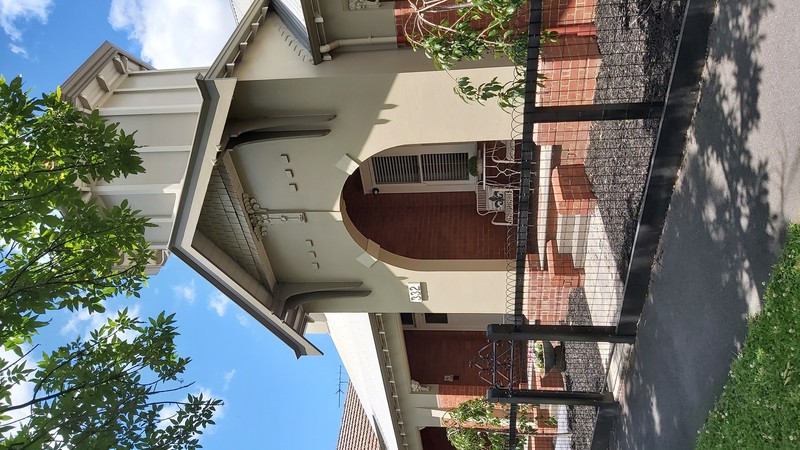ALEXANDER MILLER MEMORIAL HOMES
324 - 332 RYRIE STREET GEELONG, GREATER GEELONG CITY
-
Add to tour
You must log in to do that.
-
Share
-
Shortlist place
You must log in to do that.
- Download report







Statement of Significance
The former Alexander Miller Memorial Homes at 324-332 Ryrie Street, Geelong, were designed by the leading Geelong architectural firm, Laird and Buchan and constructed in 1913-14 by Tingate Bros. for a total cost of £1277. The five single storey row type cottages are constructed of red brick and stucco in Edwardian freestyle manner, with a prominent central tower. The Alexander Miller Memorial Homes are groups of endowed cottages or homes throughout Victoria for elderly persons in need of accommodation financed by Trust funds provided by a Scots born Geelong draper, Alexander Miller (1842-1914). The Ryrie Street group is now privately owned.
The former Alexander Miller Memorial Homes at 324-332 Ryrie Street, Geelong are of social, historic and architectural significance to the State of Victoria.
The former Alexander Miller Homes at 324-332 Ryrie Street, Geelong are important for social associations with the vital role played by private philanthropy in the history of Victorian welfare and housing which provided housing for the less fortunate prior to the establishment of public housing schemes in Victoria. They demonstrate the continuing Victorian philanthropic tradition also exemplified in Geelong by the Austin Homes.
The Ryrie Street group is important as one of the first groups of homes constructed by the prominent philanthropic businessman Alexander Miller, who established groups of endowed cottages for elderly persons in need of accommodation throughout Victoria. He was an initiator of chain-store organisation in Victoria in the latter part of the nineteenth century, and his successful business interests created the wealth which he sought to use in a Christian way.
The Ryrie Street group, constructed in the distinctive Edwardian freestyle manner, is an extraordinary work of the leading Geelong architectural firm of Laird and Buchan, and is an unusual small scale residential example of this style.
-
-
ALEXANDER MILLER MEMORIAL HOMES - History
Associated People: Owner ALEXANDER MILLER, HARRY GORDON;ALEXANDER MILLER MEMORIAL HOMES - Permit Exemptions
General Exemptions:General exemptions apply to all places and objects included in the Victorian Heritage Register (VHR). General exemptions have been designed to allow everyday activities, maintenance and changes to your property, which don’t harm its cultural heritage significance, to proceed without the need to obtain approvals under the Heritage Act 2017.Places of worship: In some circumstances, you can alter a place of worship to accommodate religious practices without a permit, but you must notify the Executive Director of Heritage Victoria before you start the works or activities at least 20 business days before the works or activities are to commence.Subdivision/consolidation: Permit exemptions exist for some subdivisions and consolidations. If the subdivision or consolidation is in accordance with a planning permit granted under Part 4 of the Planning and Environment Act 1987 and the application for the planning permit was referred to the Executive Director of Heritage Victoria as a determining referral authority, a permit is not required.Specific exemptions may also apply to your registered place or object. If applicable, these are listed below. Specific exemptions are tailored to the conservation and management needs of an individual registered place or object and set out works and activities that are exempt from the requirements of a permit. Specific exemptions prevail if they conflict with general exemptions. Find out more about heritage permit exemptions here.Specific Exemptions:General Conditions: 1. All exempted alterations are to be planned and carried out in a manner which prevents damage to the fabric of the registered place or object. General Conditions: 2. Should it become apparent during further inspection or the carrying out of works that original or previously hidden or inaccessible details of the place or object are revealed which relate to the significance of the place or object, then the exemption covering such works shall cease and the Executive Director shall be notified as soon as possible. Note: All archaeological places have the potential to contain significant sub-surface artefacts and other remains. In most cases it will be necessary to obtain approval from Heritage Victoria before the undertaking any works that have a significant sub-surface component. General Conditions: 3. If there is a conservation policy and plan approved by the Executive Director, all works shall be in accordance with it. Note: The existence of a Conservation Management Plan or a Heritage Action Plan endorsed by Heritage Victoria provides guidance for the management of the heritage values associated with the site. It may not be necessary to obtain a heritage permit for certain works specified in the management plan. General Conditions: 4. Nothing in this declaration prevents the Executive Director from amending or rescinding all or any of the permit exemptions. General Conditions: 5. Nothing in this declaration exempts owners or their agents from the responsibility to seek relevant planning or building permits from the responsible authorities where applicable. Landscape Maintenance : The following landscape maintenance works are permit exempt under section 66 of the Heritage Act 1995, a) landscape maintenance works provided the activities do not involve the removal or destruction of any significant above-ground features or sub-surface archaeological artefacts or deposits; b) watering, mowing, top-dressing and fertilising necessary for the continued health of plants, without damage or major alterations to layout, contours, plant species or other significant landscape features; c) pruning to control size, improve shape, flowering or fruiting and the removal of diseased, dead or dangerous material, not exceeding 20% of the crown of the tree within a period of two years; d) tree surgery by a qualified horticulturalist or tree surgeon necessary for the health of those plants. Public Safety and Security : The following public safety and security activities are permit exempt under section 66 of the Heritage Act 1995, a) public safety and security activities provided the works do not involve the removal or destruction of any significant above-ground structures or sub-surface archaeological artefacts or deposits; b) the erection of temporary security fencing, scaffolding, hoardings or surveillance systems to prevent unauthorised access or secure public safety which will not adversely affect significant fabric of the place including archaeological features; c) development including emergency stabilisation necessary to secure safety where a site feature has been irreparably damaged or destabilised and represents a safety risk to its users or the public. Note: Urgent or emergency site works are to be undertaken by an appropriately qualified specialist such as a structural engineer, or other heritage professional. Signage and Site Interpretation : The following Signage and Site Interpretation activities are permit exempt under section 66 of the Heritage Act 1995, a) signage and site interpretation activities provided the works do not involve the removal or destruction of any significant above-ground structures or sub-surface archaeological artefacts or deposits; b) the erection of non-illuminated signage for the purpose of ensuring public safety or to assist in the interpretation of the heritage significance of the place or object and which will not adversely affect significant fabric including landscape or archaeological features of the place or obstruct significant views of and from heritage values or items; c) signage and site interpretation products must be located and be of a suitable size so as not to obscure or damage significant fabric of the place; d) signage and site interpretation products must be able to be later removed without causing damage to the significant fabric of the place; Note: The development of signage and site interpretation products must be consistent in the use of format, text, logos, themes and other display materials. Note: Where possible, the signage and interpretation material should be consistent with other schemes developed on similar or associated sites. It may be necessary to consult with land managers and other stakeholders concerning existing schemes and strategies for signage and site interpretation. Minor Works : Note: Any Minor Works that in the opinion of the Executive Director will not adversely affect the heritage significance of the place may be exempt from the permit requirements of the Heritage Act. A person proposing to undertake minor works may submit a proposal to the Executive Director. If the Executive Director is satisfied that the proposed works will not adversely affect the heritage values of the site, the applicant may be exempted from the requirement to obtain a heritage permit. If an applicant is uncertain whether a heritage permit is required, it is recommended that the permits co-ordinator be contacted.INTERIOR DECORATIVE SCHEMES
* Interior painting / wall-papering to walls and ceilings, provided the preparation work for painting / papering does not remove evidence of the building's original paint or other decorative scheme.
* Removal of existing carpets / flexible floor coverings e.g. vinyl.
* Installation of carpets and flexible floor coverings
* Installation of curtain track, rod, blinds.
REFURBISHMENT OF BATHROOMS, TOILETS,
KITCHENS
*Refurbishment of bathroom /toilet / ensuite including removal of existing sanitary fixtures and associated piping, mirrors, and wall and floor coverings, and installation of new fixtures, and wall and floor coverings .
* Removal of existing kitchen benches and fixtures (stoves, dishwashers etc.) and floor coverings and installation of new kitchen benches and fixtures, including associated plumbing and wiring.
-
-
-
-
-
FIRST CUSTOMS HOUSE
 Victorian Heritage Register H0185
Victorian Heritage Register H0185 -
FORMER SCOTTISH CHIEFS HOTEL
 Victorian Heritage Register H0662
Victorian Heritage Register H0662 -
CORIO VILLA
 Victorian Heritage Register H0193
Victorian Heritage Register H0193
-
"1890"
 Yarra City
Yarra City -
"AMF Officers" Shed
 Moorabool Shire
Moorabool Shire -
"AQUA PROFONDA" SIGN, FITZROY POOL
 Victorian Heritage Register H1687
Victorian Heritage Register H1687
-
'NORWAY'
 Boroondara City
Boroondara City -
1 Mitchell Street
 Yarra City
Yarra City
-
-















